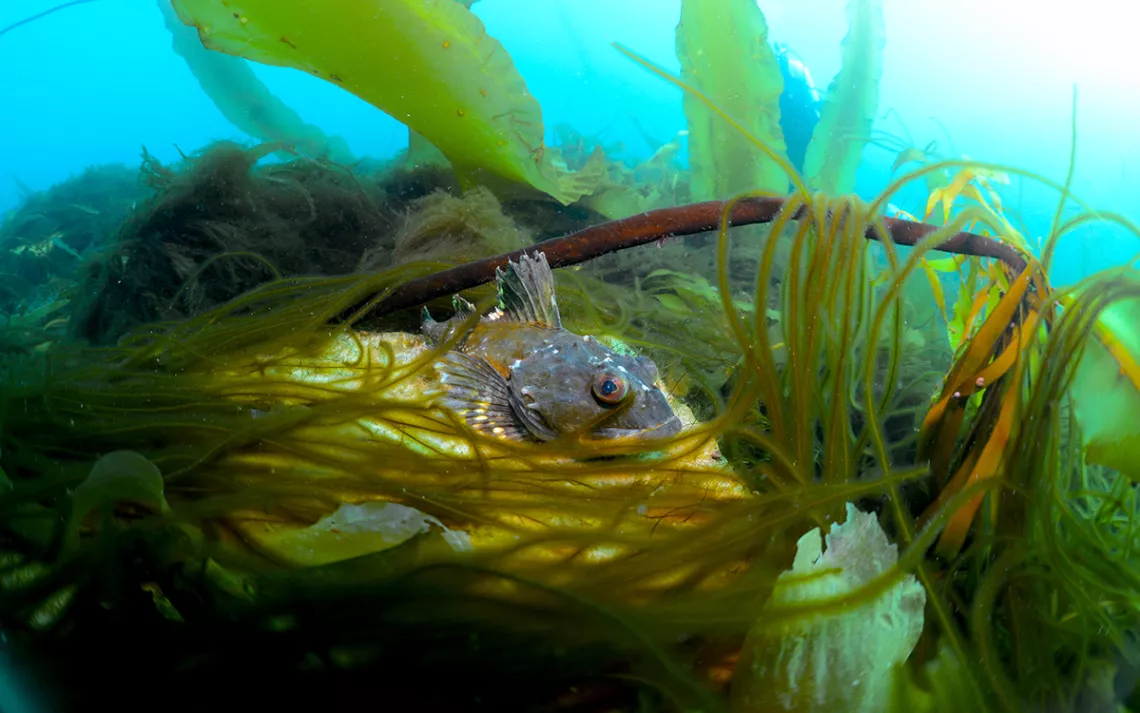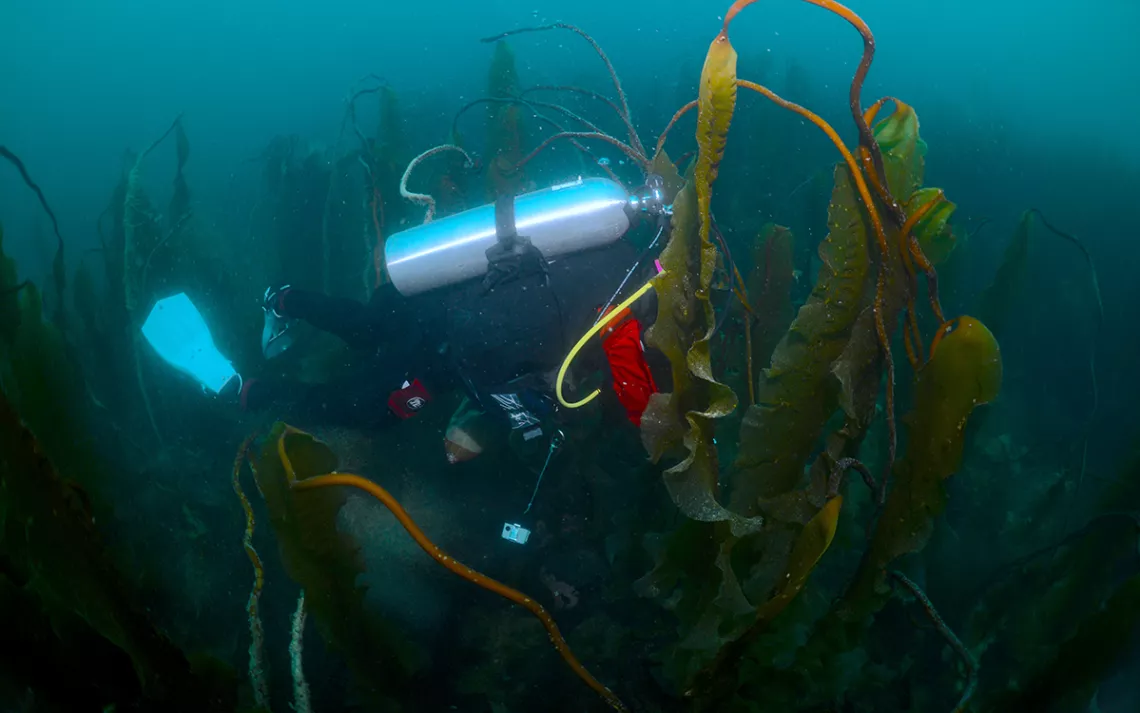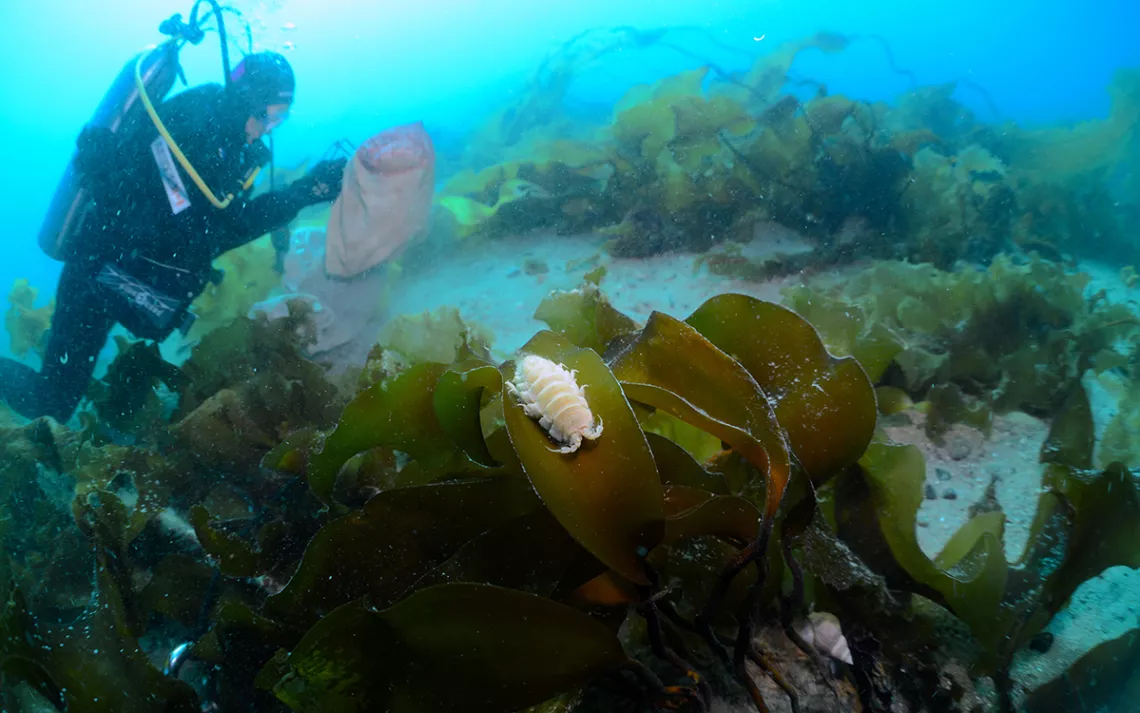Say Hello to the Arctic Kelp Rush
Could the Arctic become a kelp boomtown?

Photograph courtesy of Ignacio Garrido
In August 2019, an Arctic research vessel, the MV William Kennedy, anchored off the shore of Southampton Island, at the north end of Canada’s Hudson Bay. A group of researchers set off in a Zodiac, across waters that 30 years ago would have been covered with ice, even at this time of the year. Now there was only open water, revealing a seabed that had never before been mapped.
Southampton Island was bare of any vegetation—scoured flat by ice. But beneath the waves was vibrant with color. Tangles of Saccharina latissima, or sugar kelp, floated in dense, five-meter canopies, olive green against the Arctic blue. Another algae, Laminaria solidungula, grew wide blades in bushy clumps. A bit deeper, the underwater forest graded to the leafy Agarum clathratum, known as sieve kelp, alongside a variety of red algae.
Around the forest, the team found sea stars, brittlestars, clouds of mysid shrimps, and other crustaceans. “It was incredible,” says Karen Filbee-Dexter, who joined the expedition as a then-postdoc in biology at the University of Laval. “Some of those kelps were 10 meters long and really reminded me of those pictures you see off California of giant kelp forests.”
The only difference was that the health of California’s kelp forests—along with other well-known kelp forests around the world—is in free fall due to warming oceans. The kelp forest around Southampton was thriving—and so was the forest at other survey sites farther north, in Baffin Bay. “Everywhere we have been so far, there’s kelp, even where we were expecting no kelp,” says University of Laval biologist Philippe Archembault, also onboard the Kennedy.
In a time when kelp has become more and more critical—as a carbon sink, as habitat, as a food source, as biofuel—the discovery of these forests has set off something of a scientific kelp rush, one that has involved scientists across the whole Arctic region. The 2019 research trip to Southampton Island was part of a larger study called ArcticKelp Canada, funded through the Canadian government initiative ArcticNet to contribute to a pan-Arctic effort with two goals: one, map the extent of Arctic kelp, and two, determine kelp’s fate in a dramatically changing climate.

Say hello to big kelp
Relatively little is known about the kelp forest of the Arctic. Even though the region contains a third of the world’s coastline, it is generally not included on global kelp maps.
But it’s clear that kelp has been there for a while. In the late 1870s, Swedish botanist Frans Reinhold Kjellman rode along on the SS Vega as it attempted to find the Northeast Passage from Scandinavia to the Bering Strait and included kelp in his book The Algae of the Arctic Sea. Two decades before that, the Danish glaciologist Hinrich Johannes Rink wrote that the fjords of Greenland were filled with “a forest of gigantic algae … which together with the animal world moving between them remind one of the coral reefs of the tropical seas.” The Inuit who inhabit the coastline from the eastern Arctic to the Beaufort Sea harvest large brown algae and winged kelp to be eaten raw or cut finely to be used like a spice.
But it’s also likely that the kelp population of the Arctic is on the rise. In 2016, Inka Bartsch, an ecologist at the Alfred Wegener Institute in Bremerhaven, Germany, published a time series study in Polar Biology about kelp forests in Svalbard, the Arctic archipelago north of Norway. Between 2012 and 2013, Bartsch and her colleagues conducted dives in Kongsfjorden, or Kings Bay, on the west coast of the island of Spitsbergen, and compared kelp growth with previous data from the late 1990s.
They found that kelp biomass had increased eightfold, particularly in shallow areas where ice had once scoured away any plants before they had a chance to grow. The study concluded by citing an earlier hypothesis proposed in 2014 by marine ecologists Dorte Krause-Jensen of Aarhus University in Denmark and Carlos Duarte of King Abdullah University in Saudi Arabia: While climate disruption is decimating kelp forests closer to the Equator, the increasing lack of sea ice is turbocharging kelp growth in the Arctic by increasing the amount of light that reaches underwater. “If you have a retreat of sea ice, all of a sudden light is going to reach that very extensive, shallow coastal zone that we know can support algae,” Filbee-Dexter explains, “so you get this expansion of underwater forest.”
A few years later, on the coast of Greenland, Krause-Jensen and a team of other researchers compared kelp depth records from 2009 with more recent numbers and found that kelp were also expanding into deeper waters—sometimes more than 60 meters deep—with no sign of stopping.
In December 2020, Filbee-Dexter, Archembault, Krause-Jensen, Duarte, Bartsch, and other Arctic kelp researchers combined reports from their respective field sites into a single paper. They concluded that out of 38 sites around the Arctic, a majority showed an increase in kelp abundance, while only four showed a reduction (lack of sunlight in turbid waters and/or predation from kelp munching sea urchins were blamed). Overall, the paper concluded that “potential suitable area for Arctic macroalgae has expanded” by about 6.6 percent for the intertidal zone and 30.8 percent for the subtidal zone over the past 60 to 70 years. Unlike kelp in much of the world, Arctic kelp forests are doing well.
These results align with what scientists already know about “borealization,” or Arctic greening, the process of subarctic plant and animal species moving northward as the Arctic region warms. On land, satellite images show shrubs advancing on tundra grasses. At sea, north Atlantic fish species like cod and halibut are shifting north, often replacing populations of smaller, Arctic fish.
With Arctic sea ice extent declining at 13 percent per decade, kelp ecologists predict that the same greening may be happening in understudied coastal environments, based on the factors of sea ice and light. As the sea ice declines, more light reaches the rocky substrate at the seafloor where kelp grows. More light means more growth of kelp and other coastal vegetation. Water temperature is another factor: At the cool-edge range limit for some of these algae species, the warming temperatures are moving right into the range for optimal kelp growth.

Kelp winners, and kelp losers
A big part of ArcticKelp Canada and kelp research around the Arctic is simply putting Arctic kelp on the map. But the crux of the work now is figuring out how that map is changing, and where that map might make some money or warrant increased marine protection.
An increase in Arctic kelp abundance is good news for many species. For example, kelp is habitat. “These kelp forests host a large amount of biodiversity,” says Laura Castro De La Guardia, a University of Manitoba researcher and another member of the Southampton Island expedition. “They serve as sources for food for some animals and protection for others.”
Arctic kelp have a documented history of being a food source for humans as well. In northern Norway, for instance, the government has sponsored experimental sugar kelp farms designed to take advantage of the region’s around-the-clock sunlight—a growing season that lends to a “huge potential to develop a kelp industry.” Filbee-Dexter also sees an expanding kelp forest as a much-needed carbon sink. “There are parts of the Canadian Arctic where the kelp are five meters high and kilometers in extent. That’s a massive standing stock of carbon,” she says.
Not so fast
If only it were true, says Henry Huntington, the Arctic science director at Ocean Conservancy, in an email. Sure, kelp can store carbon. But any benefit will be hugely outweighed by the negative consequences of melting ice caps, and kelp alone can’t sequester enough carbon to make a significant dent in climate change.
Also, even if sea ice decline means more kelp, this decline would also definitely mean fewer polar bears, which depend on sea ice to move across the landscape and hunt for prey. Inuit communities also depend on the ice for hunting and travel.
Huntington suggests that ecologists don’t know how long this golden age for kelp expansion will last. Melting glaciers, permafrost thaw, and wave action along the Arctic coast—all symptoms of climate change—could cause the water in kelp areas to become murkier, reducing the sunlight that turbocharged its expansion in the first place, and bringing the boom to an abrupt end. Ship traffic, which nearly tripled in the Canadian Arctic between 1990 and 2015, may also prove a threat to any benefits of future kelp expansion.
The Arctic Council confirmed this May at a meeting in Reykjavik that the Arctic is warming at three times the global rate. It’s difficult even for scientists to predict what its future will look like. Study and gather your kelp fronds while ye may, because right now, very little in the Arctic is going to stay the same.
 The Magazine of The Sierra Club
The Magazine of The Sierra Club



